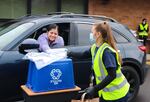Elizabeth Kirsch teaches English and oversees the newspaper at Franklin High School in Portland. It’s been three weeks since she’s seen her students – and she misses them.
“For me, it really sucks,” Kirsch said. “I’m really sad. I’m really sad I don’t get to read 'Fahrenheit 451' in class with my students. I cried about it the other day.”
Related: With Oregon Schools Likely Closed For The Year, Officials Shift To 'Distance Learning For All'
With the state’s new distance learning plan, Kirsch will have a chance to reconnect with her students. She’s already set up a teacher Instagram and hosted a Zoom call with the newspaper’s editors.
Online communicating may be one of her only options for the near future. Oregon schools are closed until at least April 28, and it’s looking like they might not reopen this year.
That leaves almost 600,000 students out of the classroom for months.
The Oregon Department of Education wants distance learning plans in place by next week to continue learning and maintain teacher-student interaction.
But Kirsch is worried about students who need extra support, including students with disabilities or those learning English.
“I also think about our students who just getting to school in the morning is an accomplishment for them, and need the support of an adult sitting by them pretty much at all times supporting them with their work, and may not live in a home environment where that’s possible right now,” Kirsch said.
The shift to distance learning means a shift away from optional lessons.
By April 13, school plans should include new material, information on grades, and high-school credit-earning options.
Some administrators are excited about the guidance. It means students can continue learning, especially if schools remain closed for the year.
But parents, teachers, and administrators have lots of questions. In a video to families distributed Friday, Portland Public Schools Superintendent Guadalupe Guerrero shared a few.
“What does this extended school closure mean for seniors? What does this mean for high school credits? What about the grades in assessing student learning?” Guerrero asked. “We hear you, and like you, anxiously await official guidance from the Oregon Department of Education.”
But there’s no question about the challenges that come with distance learning.
“There’s obviously issues for equity for our historically marginalized communities,” Portland Association of Teachers President Suzanne Cohen said. “The obvious issues of computer access, and WiFi, and quiet spaces.”
This isn’t just a Portland problem.
School districts around the state have distributed thousands of tech devices to students. Other schools and districts have 1-1 device programs already in place.

Third grade teacher Jessica Neal hands out distance learning tools and resources at Rock Creek Elementary School 's laptop giveaway on March 30, 2020.
Steven Tonthat / OPB
But there are still many students without laptops or reliable internet. They’re on the wrong side of the digital divide.
And distance learning requirements can add anxiety to the already high stress of a pandemic.
“I’m sure that there’s places that can execute it and will have no problems with it, but the reality is, that isn’t all our schools, that isn’t all our families, that isn’t all our educators,” Cohen said. “It’s not necessarily sensitive to the reality of what it’s like to be living right now during this time.”
The Oregon Department of Education says distance learning doesn’t necessarily mean online learning. Schools can use paper packets or other means to teach students – and many districts are using work packets, especially as they assess technology needs.
But as Oregon Department of Education Assistant Superintendent Jennifer Patterson told "Think Out Loud," adding more technology is a goal.
“Our commitment is to really try to amplify the assets in the home environments, to amplify the assets of our districts, and to use the tools we have in the moment while also paying very careful attention to the tools we might need to add,” Patterson said.
The state education department acknowledges equity problems, but there’s not much help for districts at this point.
Cohen said the state is expecting a great deal from educators and families.
Related: Beaverton Elementary Teachers Hold Parade for Students
“We have not put the resources into these tools or learning platforms, and we haven’t needed to,” Cohen said. “And this idea that we can do it now is asking a lot.”
Before she resumes instruction, Kirsch is preparing to just make sure her students know what’s going on.
“We’re anticipating just a lot of the battle is going to be, how are we reaching students?”
Her colleague Will Fernandez supervises Step Up, a tutoring and mentorship program at Franklin. He and a counselor tried to catch up with students on Instagram recently.
“Some students were engaging with us. I said, 'Alright, ya’ll, let’s have a Google Hangout dance party,' which is a platform that they’re supposed to use,” Fernandez said. “Multiple students were like, 'What’s Google Hangout?'”
Fernandez said equity in distance learning is possible, but it’s not going to happen overnight.
“Just like with anything in equity, you need to slow down,” Fernandez said.
But there’s not much time. Districts have a week to start rolling out plans. For many of them, the first step is to reach out to families and students.